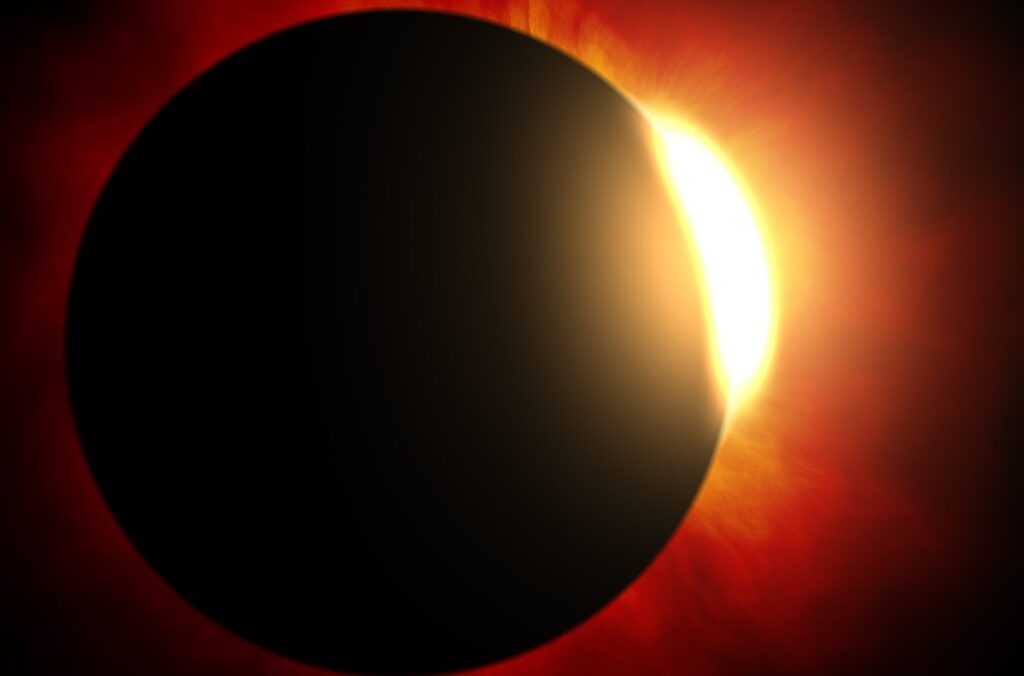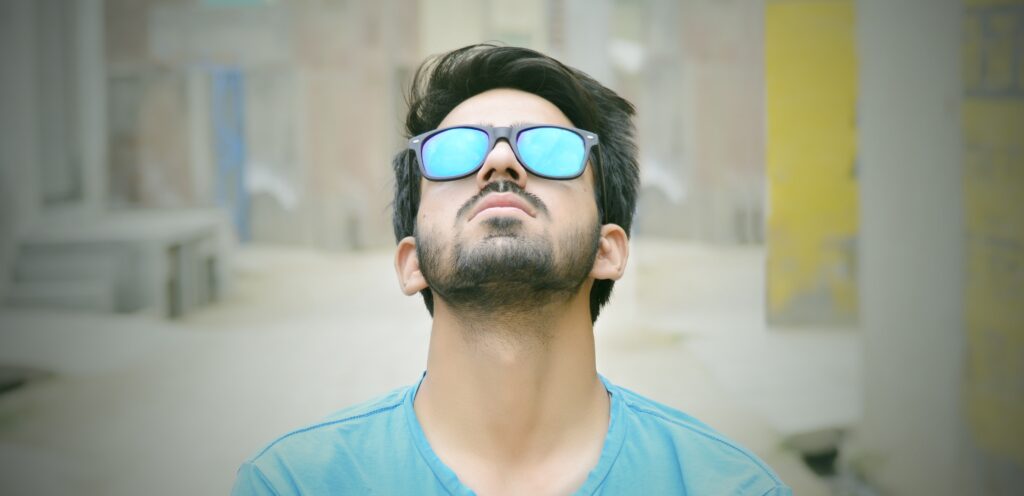How Can I Watch a Solar Eclipse Safely?

To watch a solar eclipse safely, we hope you’ve found this guide. Although being safe should be your top priority, seeing a solar eclipse is an incredible experience. This blog post will go over a number of ways you can safely observe this astronomical phenomenon without causing any damage to your eyes.
Understand the Risks:
You must be aware of the dangers of a solar eclipse before you can enjoy the thrill of seeing one. Even during an eclipse, staring directly at the sun’s intense radiation—which includes infrared (IR) and ultraviolet (UV) rays—can hurt your eyes. Without proper protection, prolonged exposure to sunlight can cause solar retinopathy and other forms of persistent eye damage, which in extreme cases can cause blindness. You must be aware of the risks involved and take all necessary measures to protect your eyes as you marvel at this celestial phenomenon.
Potential Eye Damage:
Sunlight exposure, particularly during a solar eclipse, is extremely harmful to the eyes. Solar retinopathy and other eye diseases are caused by the solar radiation’s strong ultraviolet (UV) and infrared (IR) rays, which can damage the eyes’ sensitive tissues. This harm could be permanent and cause some or all of the affected person’s eyesight to go out.
Permanent Vision Impairment:
Observing a solar eclipse without protective eyewear increases the risk of irreversible eye damage. Sunlight can cause irreversible damage to the retina, the light-sensitive tissue located in the back of the eye. Damage to the eyes can cause hazy vision, blind patches, or, in the worst cases, irreversible blindness.
Risk of Solar Retinopathy:
An explanation: Solar retinopathy develops when the eyes are exposed to solar radiation for an extended period of time, as happens when people stare directly at the sun. Damage to the retina’s light-sensitive cells causes visual impairment. Blurred or distorted vision, increased sensitivity to light, and problems distinguishing between colors are all signs of solar retinopathy. Solar retinopathy can cause irreversible visual loss if not treated quickly.
Importance of Precautions:
In light of the potential dangers to your eyes, it is imperative that you take all appropriate measures to safeguard them before, during, and after a solar eclipse. Safely observing an eclipse requires adherence to certain protocols, such as the use of certified solar viewing glasses or viewers, the avoidance of unprotected direct sunlight, and so on. Enjoying a solar eclipse without endangering one’s eyes is possible if one takes precautions beforehand.
Use Proper Eye protection.

You must be aware of the dangers of a solar eclipse before you can enjoy the thrill of seeing one. Even during an eclipse, staring directly at the sun’s intense radiation—which includes infrared (IR) and ultraviolet (UV) rays—can hurt your eyes. Without proper protection, prolonged exposure to sunlight can cause solar retinopathy and other forms of persistent eye damage, which in extreme cases can cause blindness. You must be aware of the risks involved and take all necessary measures to protect your eyes as you marvel at this celestial phenomenon.
Inadequacy of Regular Sunglasses:
Sunglasses that do not provide sufficient protection from the sun’s powerful radiation are not appropriate for watching a solar eclipse, as explained above. Although they can lessen glare, they don’t do enough to protect from UV and IR radiation. Sunglasses of the conventional variety still do not protect the eyes from the sun’s rays.
Certified Solar Viewing Glasses:
To clarify, certified solar viewing glasses are specifically engineered to shield your eyes from harmful UV rays while you see the sun. In order to guarantee that these glasses offer adequate protection from dangerous sun radiation, they are made to adhere to safety standards like ISO 12312–2. You can watch the sun safely—even during a total eclipse—thanks to their special solar filters, which block ultraviolet, infrared, and strong visible radiation.
Eclipse Viewers:
Eclipse viewers are portable instruments that resemble sun viewing glasses but provide a wider field of view. Not only that, they shield users from potentially dangerous solar rays and adhere to all applicable safety regulations. If you want to see a solar eclipse but don’t want to strain your eyes, an eclipse viewer is a great investment. Their portability, ease of use, and small weight make them ideal.
Proper Certification:
Explanation: It is essential to check the certification status of solar viewing glasses or eclipse viewers before purchasing them. Try to find items that have been safety tested and have certifications like ISO 12312, which means they offer sufficient protection from the sun. When engaging in solar viewing activities, it is important to wear certified eye protection to ensure the safety of your eyes.
Investment in Safety:
To elaborate, protecting your eyes from harmful objects is an investment in both your well-being and the longevity of your eyesight. Eclipse viewers or certified solar viewing glasses are worth the little expense because they shield you from harmful sun radiation. To safely experience the breathtaking splendor of a solar eclipse without risking permanent eye damage, safety must be your top priority.
Create a Pinhole Projector:

The construction of a pinhole projector provides a great alternative for those who favor indirect viewing methods. The eclipsed sun may be seen on a flat surface, such paper or cardboard, thanks to this easy-to-make gadget. A pin or needle, some aluminum foil, and a cardboard tube or box are all that’s needed to construct a pinhole projector. If you want to see the eclipse without risking eye damage, you can easily do it by avoiding direct sunlight.
Concept of Indirect Viewing:
A pinhole projector, which is both easy and effective, lets you see the solar eclipse indirectly, without having to stare at the sun directly. To safely see the eclipse, you can use a pinhole projector to project a picture of the sun onto a surface, like paper or cardboard, rather than staring straight at the sun.
Materials Needed:
Here are the items you’ll need to make a pinhole projector: a cardboard tube or box, aluminum foil, a needle or pin, and some white paper or cardboard. A functional pinhole projector may be quickly and simply made using several common household materials.
Assembly Instructions:
To start, cut a small square or circle into one side of the cardboard tube or box. Tape or glue the aluminum foil over the hole to make it airtight. Afterwards, make a tiny incision in the foil’s middle with a needle or pin. Inside the box, on the other side of the foil-covered entrance, lay a sheet of white paper or cardboard. Make sure the paper lies flat on the inside of the container.
Projection Process:
To make use of the pinhole projector, place it such that the foil-covered aperture faces the sun. The sun’s rays will illuminate the white paper or cardboard within the box as they pass through the pinhole. As the eclipse unfolds, you can focus the image by adjusting the distance between the pinhole and the projection surface.
Safe Observation:
The sun’s rays can cause permanent eye damage, but a pinhole projector makes it possible to see the solar eclipse in complete safety. Enjoy the eclipse’s beauty without risking your eyesight by watching it indirectly. Anyone interested in safely observing the solar eclipse can do it with a pinhole projector because they are easy to create and require minimum materials.
Explore Solar Viewing Telescopes:
An intriguing alternative is solar viewing telescopes, which allow aficionados to get a closer look at the eclipse. Solar filters allow you to view the sun’s features, such as prominences and sunspots, without being exposed to hazardous radiation, thanks to these specialist telescopes. To protect your eyes, check that the telescope’s filters are approved for use in sun viewing.
Table of Contents
Seek Expert Guidance:
Consult seasoned astronomers or members of your neighborhood astronomy club for advice on how to safely see a solar eclipse or if you simply want additional information about this fascinating phenomenon. These knowledgeable individuals can offer insightful commentary, suggest good viewing spots, and set up chances to see the eclipse through binoculars or telescopes. Improving your eclipse viewing experience while putting safety first is possible with the knowledge you gain from experienced observers.
Access to Knowledgeable Sources:
Explanation: If you want to know how to safely witness a solar eclipse, you should contact seasoned astronomers or join an astronomy group in your area. To guarantee a satisfying and risk-free eclipse watching experience, these individuals or organizations can offer helpful insights and directions.
Understanding Local Conditions:
Explanation: If you’re seeking accurate information on your viewing location’s weather and other local conditions, like when and how long the eclipse will last, you should consult an expert. To improve your chances of seeing the eclipse clearly, they can suggest viewing locations with clear skies and little light pollution.
Safety Recommendations:
Explanation: If you want to know how to safely observe the solar eclipse, you should consult with professional astronomers. Protect your eyes from harmful sun radiation by following their instructions when using solar viewing glasses, pinhole projectors, or telescopes with built-in solar filters. If you want to enjoy the eclipse without hurting your eyes, follow the advise of experts.
Access to Equipment:
To elaborate, solar telescopes or binoculars with sun filters are pieces of specialized equipment that may be available to astronomy groups or professional astronomers. These items greatly improve the viewing experience. You may enhance your eclipse viewing experience by obtaining professional advice and using high-quality equipment, which will provide you with a clearer and more immersive view.
Community Engagement:
Explanation: Getting involved with local astronomy groups or professionals can help bring people together over a common interest in the sky. There are chances to meet others who share your interests, talk about your life, and pick each other’s brains. You can get more out of your eclipse watching experience and your knowledge of the universe in general by consulting an expert.
Conclusion:
One of life’s most extraordinary experiences, a solar eclipse provides a breathtaking view of the cosmos. While taking in this celestial phenomena, it is essential to put safety first and wear eye protection. Be sure to follow all the instructions and safety measures when using any sun viewing device, whether it’s a solar telescope, a pinhole projector, or specialist glasses. Observe the beauty of a solar eclipse without endangering your eyesight by following these steps.

